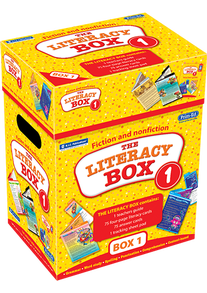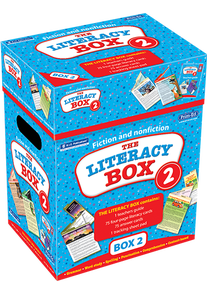-
0
Your cart is currently empty.
-
0
Your cart is currently empty.
-
The Literacy Box
The Literacy Box is a complete English programme that aims to consolidate pupils' grammar, writing, spelling and comprehension skills.
Literacy is key to success in academic subjects and in the workforce, so teaching literacy to primary school children is extremely important. The Literacy Box is an excellent way to ensure that all pupils read a variety of text types and genres, and it gives pupils a strong foundation on which to build their future learning.
Download a sample of The Literacy Box
Benefits of using The Literacy Box in the classroom
The Literacy Box can help you in your classroom today, assisting you to:
- Teach twelve comprehension strategies including fact and opinion, inference and finding information through fiction and non-fiction texts.
- Teach the correct grammar terminology.
- Teach the meanings of prefixes and root words.
- Allow your pupils to practise with questions that are in the format of the national curriculum testing.
- Use assessments to track and record each pupil's progress.
What's in the box?
The Literacy Box includes all the tools and resources teachers need to implement a successful primary school English literacy programme.
Each box includes:
- 75 cards divided into 15 colour-coded sections.
- Each colour-coded section has 5 cards.
- Comprehension, word study and grammar questions in multiple-choice format.
- Teachers Guide containing 200+ pages of supplementary material.
- Progression Guide.
- 75 answer cards.
Complete English programme for teachers and pupils
Prim-Ed Publishing has a range of resources designed for primary school learners and teachers, supporting the UK curriculum.
Three boxed resources in The Literacy Box series are available for your classroom:
- The Literacy Box 1 - created for use with Years 1 and 2, and P2/P3.
- The Literacy Box 2 - created for use with Years 3 and 4, and P4/P5.
- The Literacy Box 3 - created for use with Years 5 and 6, and P6/P7.
All the resources are brightly coloured and engaging, with clear instructions. They are also differentiated, with coloured cards ordered by difficulty to help select the best cards for the needs of your pupils.
The Literacy Box is an essential resource for any primary teacher. It will consolidate pupils' grammar, writing, spelling and comprehension skills.
Teaching literacy from a young age
Most people would agree that being able to read and write are fundamental skills that everyone should possess. However, what many people may not realise is just how important it is for children to start learning these skills at a young age.
If children don't have a good understanding of these basic skills by the time they reach secondary school, they can quickly fall behind their classmates.
So, by using a programme like The Literacy Box, teachers can help to ensure that their pupils have the best possible chance of succeeding in life.
Designed to teach twelve comprehension strategies
The Literacy Box series aims to teach twelve comprehension strategies including fact and opinion, inference and finding information through fiction and non-fiction texts. These are the strategies identified in the national curriculum for English as being the most important for children to learn.
The series covers twelve comprehension strategies including:
Finding information
Finding information is a comprehension strategy that helps pupils locate specific information in a text. This can be useful when answering comprehension questions or writing essays. Pupils learn to read strategically, scanning the text for the most critical information before reading it in depth.
Identifying the main idea
The main idea of a text can be identified by extracting the most important message or topic from it. This strategy helps to focus on the most critical information and understand the overall point of the text.
Sequencing
Sequencing is the ability to understand the order of events in a text. This comprehension strategy is often taught through stories, where pupils are asked to identify the main events and put them in order. Sequencing can also be used when learning about non-fiction texts, such as historical events or scientific processes.
Finding similarities and differences
Finding similarities and differences is a comprehension strategy that helps pupils compare and contrast two or more texts. Finding similarities and differences between characters, events or ideas can help pupils to understand texts better and make connections between them.
Predicting
The comprehension strategy of predicting is learning to anticipate what will happen next in a text. This can be done by using clues from the text itself, as well as from personal knowledge and experience. Predicting helps readers to stay focused on the story and makes reading more enjoyable.
Concluding
Concluding involves pupils reflecting on or retelling the stories in their own words, in order to draw their own conclusions on the meaning. By doing this, they are able to better process and understand the information presented in the text.
Summarising
Summarising is the ability to extract the most important information from a text and present it in a concise form. Pupils learn to identify the main idea of a text, as well as the most important details, and then to express this information in their own words.
Inferring
Inferring is the ability to read between the lines and understand what the author is hinting at. Pupils learn to make deductions based on what they know about a text and to use this information to build a deeper understanding. Inferring helps pupils to develop their own ideas and interpretations, as well as their critical thinking skills.
Cause and effect
Cause and effect is the strategy of understanding how one event leads to another. It can be found in both fiction and non-fiction texts and helps pupils to make connections between events, understand why things happen, and predict what might happen next.
Fact or opinion
Fact or opinion is a comprehension strategy that helps pupils to identify information that is based on fact or information that is based on opinion. Pupils learn how to distinguish between the two types of information and how to use this knowledge to develop their understanding of a text.
Writer’s point of view and purpose
The writer's point of view and purpose comprehension strategy is all about understanding the author's perspective and why they wrote the text. This can be done by thinking about the author's purpose for writing, as well as what they hope to achieve with their readers. By understanding the writer's point of view, pupils can better understand and appreciate the text.
Develop pupils' vocabulary, grammar and word study skills
The Literacy Box provides an abundance of resources to assist in teaching spelling skills and word reading, vocabulary and correct grammar terminology.
The programme includes a range of activities and exercises that can help pupils learn comprehension strategies and understand the meanings of prefixes and root words. This can ultimately help improve pupils' writing and spelling abilities.
Packed with over 200 pages of supplementary material, the Teachers Guide provides comprehensive teacher's notes and suggestions for additional activities that extend beyond the literacy cards.
By doing this, it helps to consolidate the basic literacy skills that children need in order to be successful readers and writers.
Pupil progress, progression guides and assessments
The series provides assessments that allow your pupils to practise with multiple-choice format questions that are in the structure of the national tests. This is extremely beneficial, as it means that they can become familiar with the types of questions they will be expected to answer in real assessments.
Progression Guides will indicate where to start your pupils in the box and pupil progress can be monitored using the assessments. Download the Progression Guide for each level.
- Progression Guide - The Literacy Box 1
- Progression Guide - The Literacy Box 2
- Progression Guide - The Literacy Box 3
Working through these cards will lead to increased confidence when sitting a test as pupils will have had consistent practice with the key terminology.
Overall, The Literacy Box is an excellent resource for teachers who want to help their pupils to work independently and improve their literacy skills.
Prim-Ed Publishing offers a range of English resources that are perfect for consolidating pupils' grammar, writing, spelling and comprehension skills. The resources include worksheets and teacher guides, which can be used in the classroom or at home. To view the latest products and to find out more, please get in touch or download our catalogue.
Frequently asked questions
What age group is The Literacy Box designed for?
The Literacy Box is designed for Key Stage 1 and 2 pupils, which are Years 1-6 in England’s education system. It can be used for children who are reading above or below year level, and it can also be adapted to work with pupils with disabilities.
How many different boxes are available?
The Literacy Box has three different levels so teachers can adjust the difficulty of the tasks as children progress: Literacy Box 1, Literacy Box 2 and Literacy Box 3.
What materials are included in the box?
The Literacy Box is a fantastic resource for teachers and pupils alike. It contains a wealth of teaching materials, including fiction and non-fiction texts, cross-curricular activities, word study and grammar questions, and more.
- The materials are divided into 15 colour-coded sections.
- Each colour-coded section contains 5 cards.
- Teachers Guide with over 200 pages of supplementary material and comprehensive teacher’s notes.
- Progression Guide.
- 75 separate answer cards to allow pupils to work independently.
- Additional ‘Something Extra’ language or cross-curricular activities
What type of literacy activities can be found in The Literacy Box?
Each box includes a mix of multiple-choice format questions, fiction and non-fiction texts, and engaging cross-curricular activities that will make learning fun. The wide range of texts covered in The Literacy Box ensures that there is something for everyone.
How can I use The Literacy Box in my instruction?
The Literacy Box is a great resource for literacy instruction. It provides separate answer cards, tracking sheets and pupil progress reports to help teachers tailor their instruction to each pupil’s needs. In addition, the cards offer suggestions for extra activities that can supplement your instruction. The Teachers Guide contains over 200 pages of supplementary material, including detailed teacher notes and suggestions for additional activities. By using The Literacy Box in your instruction, you will be able to better meet the needs of your pupils and help them succeed in their literacy development.
How can you teach pupils the comprehension strategy ‘writer’s point of view and purpose’?
The comprehension strategy of the writer’s point of view and purpose helps pupils to understand the author’s perspective on the text and their reasons for writing it. This can be accomplished by asking questions such as, “Who is the narrator?”, “What is their opinion?” and “Why do you think the author wrote this piece?” Pupils can then use this information to better understand the text and form their own opinions.


